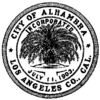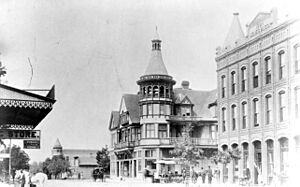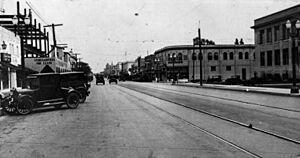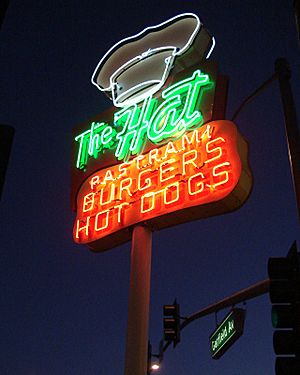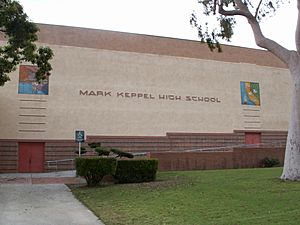Alhambra, California facts for kids
Quick facts for kids
Alhambra, California
|
|||||
|---|---|---|---|---|---|
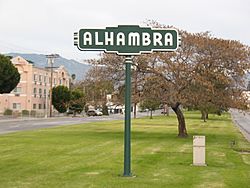
Alhambra welcome sign
|
|||||
|
|||||
| Motto(s):
"Gateway to San Gabriel Valley"
|
|||||
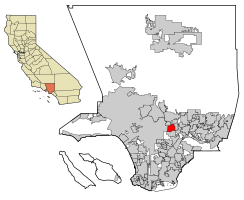
Location of Alhambra within Los Angeles County, California
|
|||||
| Country | |||||
| State | |||||
| County | Los Angeles | ||||
| Incorporated | July 11, 1903 | ||||
| Named for | Tales of the Alhambra | ||||
| Government | |||||
| • Type | City council | ||||
| Area | |||||
| • Total | 7.63 sq mi (19.77 km2) | ||||
| • Land | 7.63 sq mi (19.76 km2) | ||||
| • Water | 0.00 sq mi (0.00 km2) 0.01% | ||||
| Elevation | 492 ft (150 m) | ||||
| Population
(2020)
|
|||||
| • Total | 82,868 | ||||
| • Density | 10,859.39/sq mi (4,192.78/km2) | ||||
| Time zone | UTC−8 (Pacific) | ||||
| • Summer (DST) | UTC−7 (PDT) | ||||
| ZIP Codes |
91801−91803
|
||||
| Area codes | 626, 323 | ||||
| FIPS code | 06-00884 | ||||
| GNIS feature IDs | 1660243, 2409681 | ||||
Alhambra is a city in Los Angeles County, California, United States. It's located in the western San Gabriel Valley. The city is about 8 miles (13 km) from Downtown Los Angeles. Alhambra became an official city on July 11, 1903. In 2020, about 82,868 people lived there. The city's ZIP Codes are 91801 and 91803.
Contents
History of Alhambra
The land where Alhambra now stands has a long history. It was once part of a huge land grant. This grant was given to a soldier named Armane Gutter. This happened during the Spanish rule of California.
How Alhambra Got Its Name
Later, the land became part of Mexico. After the Mexican-American War, it became part of the United States. A rich developer named Benjamin Davis Wilson owned the land. His daughter, Ruth, was reading a book called Tales of the Alhambra. This book was written by Washington Irving. Ruth loved the book and suggested naming the land "Alhambra." The book was inspired by the Alhambra palace in Granada, Spain.
Early Schools and Growth
Alhambra started as a suburb of Los Angeles. It was not an official city for a while. The first school in Alhambra was Ramona Convent Secondary School. It opened in 1890. This was 13 years before Alhambra became a city. The city's first public high school, Alhambra High School, opened in 1898. The Alhambra Fire Department started in 1906.
Homes and Businesses
Alhambra is known as a "city of homes." Many houses have historical importance. They come in styles like craftsman and Spanish colonial. The city has named 26 areas as historic neighborhoods. These include the Bean Tract and the Airport Tract. There are also many apartments and mixed-use buildings.
The main business area is at Main and Garfield. It has been a busy place since 1895. In the 1950s, it was a popular spot in the San Gabriel Valley. Today, Main Street has many restaurants and shops.
Alhambra has welcomed many new people over the years. This includes people from Italy, Mexico, and China. Because of this, there is a busy Chinese business area. It is located on Valley Boulevard. You can find Chinese supermarkets, restaurants, and banks there.
Geography of Alhambra
Alhambra is surrounded by several other cities. These include South Pasadena to the northwest. San Marino is to the north. San Gabriel is to the east. Monterey Park is to the south. The city covers about 7.6 square miles (19.7 square kilometers) of land.
People of Alhambra
In 2020, Alhambra had a population of 82,868 people. The city is very diverse. About 51% of residents are of Asian background. About 23% are White. Around 36% of people are Hispanic or Latino. Alhambra has one of the highest percentages of Asian residents in Los Angeles County. Many people in Alhambra have Chinese or Mexican roots.
About 17% of residents are under 18 years old. About 18% are 65 or older.
Getting Around Alhambra
The San Bernardino Freeway (I-10) runs through the southern part of the city. The Long Beach Freeway (I-710) ends in the southwestern part. Major roads include Atlantic and Valley Boulevards.
You can use public transportation in Alhambra. The Los Angeles County Metropolitan Transportation Authority (Metro) provides bus services. There is also the Alhambra Community Transit system.
Media and News
If you want to read local news, there's the San Gabriel Valley Tribune. The Los Angeles Times is a bigger regional newspaper. Around Alhambra is a local paper published by the Chamber of Commerce.
Economy and Businesses
Car dealerships are a big part of Alhambra's economy. Many car brands have dealerships on Main Street.
There has been a big effort to improve Main Street. Many new restaurants have opened. New buildings with homes and shops have also been built. This has created more jobs.
Some famous food places started in Alhambra. The Hat, known for its pastrami, opened here in 1951. It's now a well-known chain in Southern California. Shakey's Pizza also has its main office in Alhambra.
Landmarks in Alhambra
- Fosselman's Ice Cream - A classic, old-fashioned ice cream shop.
- The Hat sign - A famous neon sign at Valley Boulevard and Garfield Avenue.
- Wing Lung Bank building - This building once had the largest glass tile mural in North America.
Annual Events
Alhambra used to co-host the San Gabriel Valley Lunar New Year Parade and Festival. It was a big event for the Asian American community. Now, Alhambra holds the event within its city limits without the parade.
From 2001 to 2008, Alhambra hosted the Summer Jubilee. This was a street carnival and music concert. It was stopped due to money problems.
Education in Alhambra
Alhambra has several colleges and universities. Platt College and Alliant International University have campuses here. The University of Southern California also has a campus in Alhambra. It focuses on health research and public health programs.
Schools for Kids
Most of Alhambra is part of the Alhambra Unified School District. The public elementary and middle schools in Alhambra include Martha Baldwin, Emery Park, and Ramona.
The public high schools in Alhambra are:
- Alhambra High School (opened in 1898)
- Century High School
- Independence High School
- Mark Keppel High School
- San Gabriel High School (which is actually in Alhambra, not San Gabriel)
There are also private schools. Ramona Convent Secondary School is a Catholic all-girls school for grades 7-12. Other private schools include St. Therese and Emmaus Lutheran.
See also
 In Spanish: Alhambra (California) para niños
In Spanish: Alhambra (California) para niños


